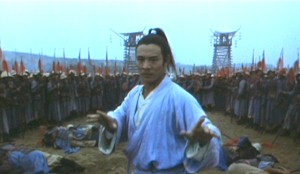
The flow drill model of push hands
I have classed push hands into a few categories. One of them is a flow drill model. I believe these flow drills will teach a student to naturally move in a strategically beneficial way, naturally and easily.
In the first video I like the fact they have dynamic motion to their flow drill style of push hands. They move all over, switching patterns and ranges. They move seamlessly from inside to outside grips. I think there is a lot of good learning going on here.
One one big criticism of the flow drill model of push hands is that they remain at a constant homeostasis. Neither player wins or loses posture of balance at any point. With this practice they are learning to stay even at all times, rather than starting a relationship where real problems need to be solved, or any real problems are caused. My push hands I have been working on I hope will look like this first video, but there will be a steady chain of balance breaks and technique entries. Flow, but give each other problems to solve.
I have watched the following video countless times. Lots to be learned here. The reasons it made a link, rather than featured video here is overly low stances, and over emphasis on fixed step work.
Another nice flow drill push hands video
Fixed Step
The fixed step model of push hands seems to be the most common form practiced. While it has has uses, the practice of it should be used only for the most basic...and maybe fine tuned advanced work. It creates an artificial game.
There are a few artists using it interestingly. I really like the nice balance breaks this gentleman gets at the beginning of this video. There seems to be a genuine exercise going on here rather than seeing this as the totality of reality.
My criticism of some parts of this video again comes from adhering to this model to much. At a few moments there is some artificial posture breaking that could be corrected by stepping. Also there are a few moments of timing breaking - speeding up, that I think should be avoided. Overall though I really enjoy this video. I love the emphasis on balance breaking.
This next film I like. They move interesting. They give problems to each other. I really like some of the problems, yet they are unattached enough to technique that they do not have to chase it to conclusion. They go static, then they move. Their work is still in the realm of drill, but it is successful free play and drill that makes it dynamic, and makes the art form still work.
And finally my award for the greatest demonstration of push hands I have seen is from Master Ma Yu Liang. Softness and controlled technique is the game. There is some fine tune kuzushi, balance breaking, that is masterful. He respects the safety of his partners. I really hope I am doing work this subtle and nice in my lifetime. It is not bad for a 93 year old.







In fixed step, you HAVE to learn to yield, turn from the waist, etc.; because you can't change your position. It's for building basic skills.
ReplyDeleteWhile not necessarily pushing hands, the video linked below is that of Chen Zhonghua demonstrating form applications within the context of push hands. It is truly a learning video as he points out error and how to handle certain situations.
ReplyDeletehttp://www.youtube.com/watch?v=zUDNr8v7eRI
I like the Liu Xi Wen clip you posted ;)